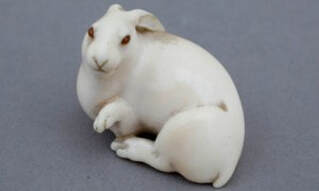|
The story is based upon a collection of antique Japanese ivory carvings and the changing fortunes of their owners, from immensely rich Jewish merchants to the present owner, a potter, who is the author of the book. The story has a particular resonance for me because for many years I collected antique Japanese ivory pieces (known as okimono, from the Meiji period, 1868-1912) and only stopped adding to the collection when I ran out of space to display them. Ivory is deeply unfashionable because no-one wants to be associated with the trade in elephant’s trunks, and this taint has meant that these beautiful works of art which have been carved with astonishing skill can be bought relatively cheaply.
When I first took my family to Japan several years ago the first thing I wanted to do was to look at the collections of ivory in the Tokyo museums and to see what was for sale in their antique shops. I was surprised to find that the Japanese have almost no interest in okimono and that the National Museum in Ueno has almost no ivory objects on display. The Hare with Amber eyes is a story about netsuke, a small toggle used to tie the belt of a garment. When, in the middle of the nineteenth century, the fashion for using netsukes fell, the craftsmen whose livelihood was threatened turned to making okimonos for the export market. The purchase by Charles Ephrussi of a collection of netsuke in Paris was a reflection of the craze for Japanese art in Victorian times, and we continue to admire these objects now, but the fashion has never caught on in Japan itself.
0 Comments
Leave a Reply. |
|


 RSS Feed
RSS Feed